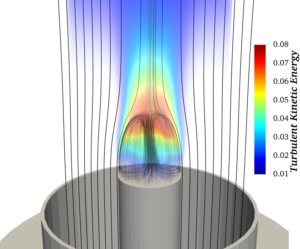
Goal: More than 80% of the energy used by humanity comes from combustion processes, which are present in several industries including mining, chemical, steel, cement, glass and transportation. In some large cities, soot, one of the main pollutants generated from combustion processes, exceed the protection thresholds recommended by the WHO. The development of control measures to limit the level of soot formed in the referred industries is therefore paramount. Accordingly, the main goal is to identify in turbulent combustion processes, via numerical modeling based on computational fluid dynamics (CFD), the main chemical species responsible for soot formation, in order to reduce the impact of this pollutant on both health and environment. In particular, combustion processes characterizing bluff body like burner configurations and hybrid Large Eddy Simulation/Filtered Density Function approaches will be accounted for.
Fecha de inicio: 26/12/2019Fecha final: 25/12/2023
Estado DGI: Cerrado
Instituciones Investigadoras:
PUCP
PUC-Rio
Instituciones Financiadoras:
FONDECYT
